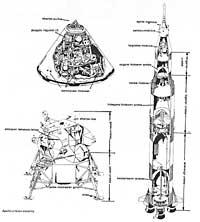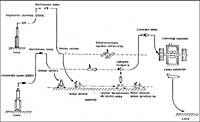What are the plans of the American space?
1988/08/01 Barandiaran, Mariaje | Irazabalbeitia, Inaki - kimikaria eta zientzia-dibulgatzaileaElhuyar Fundazioa Iturria: Elhuyar aldizkaria
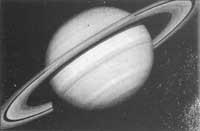
Since we have to start somewhere, we will first explain the purpose of the report. The first reading of the report clearly shows this trend: The US must again reach a first level in space exploration. Leader and Leadership are words of Dr. Ride. The speaker believes that the US has been dominating the exploration of space and that this leadership will be maintained.
This attitude is, in our image, quite Txobinist, since if the US has reached an undeniable level in some areas of space exploration, such as the first man's ilargation, the Soviets have not been left behind in others, as in the exploration of Venus. In addition, we believe that there have been times when the exploration of space must be carried out with the effort of a single people and that it should now be international cooperation that dominates. For his part, Dr. Ride consciously rejects this collaboration and states that such exploration must be carried out in the Ad Maiorem gloriam of the United States. (1)
"Being an effective leader does mandate, however, that this country have capabilities which enable it to act independly and impressively when and where it chooses, and that its goals be capable of inspiring others —at home and abroad— to support them."
(Being an effective leader, however, forces this country to have the ability to act independently and impressively in the place and time it chooses and to make its goals as stimulating as others, both at home and abroad.)
"... the nation's desire to regain and retain space leadership."
("The nation wants to regain and maintain space leadership.")
In any case, this report will mark the future US space exploration policy. In the coming years, 1990-2010, the American effort will follow four major lines: the Mission of Planet Earth, the Exploration of the Solar System, the Permanent Base of the Moon and Man to the lines of Mars.
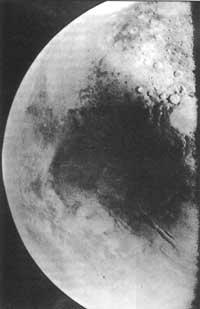
These goals are very ambitious. In addition, as in his day the Apollo project had, the paths of exploration of space seem, at first glance, too large for a single country, which is the world leader, to carry it out.
Mission of planet Earth
The objective of the project called Mission of Planet Earth (MP) is our planet, as indicated by the title. It is about understanding our planet, knowing what are the forces that alter and cause the environment, how the environment is changing and how those changes affect us. The aim of this project is to achieve a deep scientific knowledge of the whole earth.
There are many biological, chemical and physical processes that interact with each other that connect in a complex way oceans, continents, atmosphere and biosphere. The ocean, ice-covered territories and atmosphere directly influence the climate. Vulcanism unites the interior of the Earth with the atmosphere. And biological actions recycle the necessary elements for life. At present, the influence of humanity is very evident in the environment. The problem of the gases that cause the increase in the temperature of the atmosphere (carbon dioxide and methane) or the hole of the ozone layer detected in Antarctica or the uncontrolled discharges of forests, are witnesses of this increasing effect.
To understand these complex relationships and to know to what extent human influence can condition the future of our planet it is necessary to carry out an exhaustive analysis.
In short, the obligation of MPL is to carry out this study.
The LDC will have two main parts. On the one hand, the resources that will collect the data, the observation satellites. And on the other hand, the treatment and modeling of all this data.
The observation system will consist of nine satellites that will orbit the Earth. Four of these satellites will circulate through solar synchronous polar orbits and secure the covering of the entire Earth. The first will be launched in 1994 and the last in 1997. The other five satellites will circulate in geostable orbits and will be launched between 1996 and 2000.
This system will measure, among other parameters, cloud cover, vegetation cover, ice cover, rains, humidity, chlorophyll production of the oceans, movements and deformations of Earth's tectonic plates and atmospheric concentration of some gases (carbon dioxide, methane and ozone).
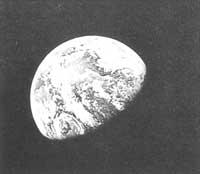
The LPM project is not very spectacular (that is, it attracts the attention of ordinary taxpayer people), but it has an undeniable importance to delve into knowledge about the Earth and predict the phenomena that may occur in the future.
Solar System Scan
This project will follow one of NASA's traditions, marked by Voyager and Pioneer. This project includes missions of three types: comet and asteroid mission (CRAF), mission to Saturn (Cassini) and reversible sampling probes to Mars (3 in total).
The CRAF mission will analyze the origin of our system by investigating the main asteroid belt and a comet. These are witnesses of the birth of the Solar System. Analyzing the asteroids and comets we can come to understand better how our system emerged.
The CRAF will leave the Earth in 1993 and after a six-month trip will encounter the asteroid Hestia. It analyzes the intestine at a distance of 10,000 km by auditory and infrared waves. This limits the shape and composition of the surface. Then continue your journey until you find comet Tempel 2. It will be located at the height of the comet, 25 km from the area, with whom it will travel to the Sun. Meanwhile, he will conduct numerous sessions and research. When the comet area is activated with the approach to the Sun, the boat, the comet's comet and tail are thrown into the studio.
The Cassini mission will conquer Saturn and its largest satellite, Titan. Titan is especially interesting because inside it develops a very interesting organic chemistry. It can be a planet-sized laboratory to reproduce the conditions that preceded the creation of life on Earth.
This mission will be launched in 1998 and after a long trip will arrive in Saturn in 2005. Then the large tooling starts working. The space will consist of four probes. Three will analyze Saturn's rings, satellites and magnetosphere for three years. The other probe will be sent to the Titane and will perform a semi-soft titanium on the surface of the Titan.
The automatic mission to Mars is very striking. After being launched from Earth they will reach Mars. There they will be gently marked, samples will be collected and they will be brought to Earth. There will be three missions in total. The first two will be projected in 1996 for samples to remain on Earth in 1999. The third will be launched in 1999.
These missions will analyze and facilitate the path of Man's Tuesday.
Moon Base
This project inherits the Apollo boats and reinforces the exploration of the Moon. The scientific study of the Moon and the analysis of the resources of the Moon will be the two main objectives. It will be the first step in learning to survive in strange and hostile worlds.
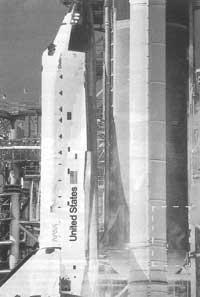
This new exploration of the Moon will begin in the 1990s with automatic probes. For the year 2000 it is intended to carry out the exploration by astronauts and the implementation of a permanent base.
The Moon has a very suitable environment for scientific advances. The Moon is stable from the seismological point of view, has no atmosphere and its hidden side is protected from radio waves generated on Earth. It is therefore the ideal place to work in astrophysics. The same can be said of particle physics. In addition, as the force of its gravity is the sixth part of the Earth, the science of materials and biological sciences will have a very appropriate laboratory for our satellite.
The frame of the lunar base will be carried out in three phases.
- Local evolution (1990s): In this first phase, the exploration will be carried out using Ilagia robots. It begins with the launch of the Lunar Geoscience Observer satellite. This will mark the surface, conduct geochemical studies and monitor the presence of water at the poles. From the data collected by the Observer, automatic ring probes will be sent to collect more data on the specific site. In this way the most suitable places for the implementation of the base will be searched and identified.
- Return to the Moon (2000-2005): The second phase will begin with the return of the astronauts. The astronauts will reach the surface of the Moon from the space station and with them the necessary equipment. The crew will hold one or two weeks on the Moon, during which they will deposit and prepare the necessary material for the construction of a pilot plant and a habitable module for the dissemination of scientific instruments and the synthesis of oxygen. In the following flights the base will grow and the necessary modules and habitacles will be added. By 2001, astronauts will have the means to last a lunar night (14 terrestrial days). By 2005 it is intended that 5 people can maintain the base for several months.
- Casa de la Luna (2005-2010): This step is a direct consequence of the above. The goal is to achieve a permanently inhabited base and gradually an increasingly self-sufficient base. 30 people will live simultaneously on the Moon by 2010.
Man on Mars
Of all the projects, this is undoubtedly the one that generates the most attraction and interest in society. Not only because man comes to a planet that is not ours, but for all the fascinating stories that have been built for centuries on Mars. The work will begin with automatic probes, the man will go later and the final objective will be a lasting basis.
The first step of this new exploration at Martitz will be done with robot probes throughout the 1990s. The first mission will be Mars Observer. And the last of the automatic exploration will be two missions that will collect surface samples on Mars and return them to Earth. In these missions will be the chemical characterization of the planet, the complete mapping and the search for the most suitable places for Tuesday.
Another important aspect will develop in the space station. Will their sessions analyze the physical and psychological consequences that can be derived from long-lasting flights (Americans will take into account the deep experiences of the Soviets in this field? ).
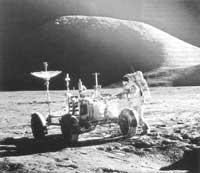
Americans want to place their first astronauts on Mars around 2005. It is not clear that he will be the first human to leave, because the Soviet plans for Mars are more advanced and the steps that are being taken on that path have already begun some time ago. The Fobos mission or the long lasting flights of years mentioned in number 15 are witnesses to this.
Americans propose quick missions that will last a year. This reduces the mass to be expelled from the Earth. The mission will consist of two parts: on the one hand the ship of the astronauts and on the other an automatic probe that will carry the load. The cargo ship will be launched earlier and will travel to Mars at low cost and long duration. The Astronaut's ship will be moored in orbit and heading for Mars only after the orbit of Mars is taken. There will be six astronauts and the necessary means to maintain them. In Martitz's orbit they hit the load, catch the fuel and finally mark. After 2 weeks in March they will return to Earth.
The last step, the permanent base of Martitz, will take place in 2010 if the project meets the deadlines.
* - * - * - *
There is no doubt that American plans are big and ambitious. But perhaps this approach has an original error, that they want to do everything. And entering into such tremendous projects alone can make it not all stand. If the failure occurred (and we don't want that), the civil exploration of the American space could be delayed for many years, as has happened in the case of the Challenger.
(1) However, the most common Americans seem to have a broader view. Last May, the results of a survey among readers of the magazine "Astronomy" were published. The survey referred to the Ride report. Among the answers received were the need for collaboration in space exploration, although there were no questions in the questionnaires.

Gai honi buruzko eduki gehiago
Elhuyarrek garatutako teknologia




